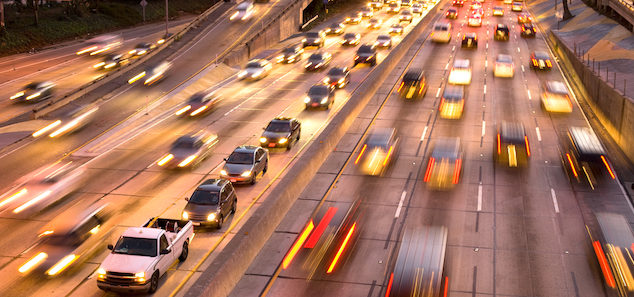News
CA cars: Supply slows, while prices head to the fast lane
 Traffic on Harbor Freeway in downtown Los Angeles.(Photo: Jose Luis Stephens)
Traffic on Harbor Freeway in downtown Los Angeles.(Photo: Jose Luis Stephens)Several factors are shaping demand, prices, sales and supply of new and used cars in the Golden State, but consumers know one thing — their pocketbooks are taking a hit.
Jessica Caldwell is Edmunds’ executive director of insights, based in Santa Monica. “There has never been a greater imbalance of supply and demand for vehicles as there is right now across the country, including the nation’s largest automotive market, California,” she says.
By one estimate, new car prices rose 12.1 percent between September 2020 and September 2021, or about $4,871 per vehicle. The average cost of a new car has surpassed $45,000 — an historic first.
The California Auto Outlook for the second quarter of 2021 forecasts that new car sales could rise 15 percent from 2020, approaching 1.9 million units
Lewis Black is director, president and CEO of Almonty Industries, a global raw materials development company that mines for tungsten—an integral material in electronics and semiconductors. He concurs with Caldwell’s assessment of low supply and high demand California’s car market.
“It is a classic example of a supply squeeze,” Black says. He explains why. “Carmakers’ production is down due to car part shortages in semiconductors and polymers.”
Brian Maas helms the California New Car Dealers Association. “Each new car has thousands of computer chips in it,” he says. “There are certain global companies in nations such as South Korea and Taiwan that make these chips. The U.S. was an industry leader a couple of decades ago before companies relocated such production abroad. That’s led to Congressional discussion of returning computer chip production stateside.”
The California Auto Outlook for the second quarter of 2021 forecasts that new car sales could rise 15 percent from 2020, approaching 1.9 million units. For the first two quarters of 2021, there was a 35.1 percent increase across the state.
New car sale increases varied by region, according to the CAO. “Southern California led very slightly with 35.3 percent to Northern California’s 34.9 percent. More specifically for selected markets, San Diego County saw a raise in 35.2 percent, LA and Orange counties an increase of 32.9 percent, and the Bay Area an increase of 29.7 percent.”
Such market turmoil with respect to demand, prices and supply arrives after 20 months of the COVID-19 pandemic.
Meanwhile, a global chip shortage that has driven down new car supply is also affecting the market for used cars. Sellers of previously owned vehicles are in a good spot. Credit the increased demand for used cars, according to Caldwell.
“This imbalance between very limited inventory and soaring demand has caused both new and used prices to skyrocket to levels that have never been seen before in either market,” she says.
Such market turmoil with respect to demand, prices and supply arrives after 20 months of the COVID-19 pandemic, with school closures and labor force layoffs hammering the Golden State’s economy. There is a positive aspect to the post-pandemic shutdowns. Case in point is the pent-up demand to travel as vaccination rates are rising in the Golden State, with the 5-11 year-old-group becoming eligible for the Pfizer jab recently.
“Consumers have been eager to hit the road again as pandemic restrictions eased and schools, businesses and workplaces opened back up,” Caldwell says. Such a trend increases the consumption that fuels economic growth.
That is good for the seller, not so much for the buyer. Price hikes can and do spur inflation, which can eat into buying power.
One unresolved pandemic trend is supply chain congestion at West Coast ports. When the resolution does come, the prices of new and used vehicles should decrease all things equal.
At the state Capitol, The California State Assembly and Senate held a joint informational hearing on Nov. 4 to address congestion at the Ports of Los Angeles and Long Beach, seeking solutions now and later to this crisis.
Meanwhile, new and used auto price hikes are having uneven impacts on Californians.
Amir Daneshvar is the general manager at Zen Auto in East Sacramento. “Major dealerships have financial capital and can control the market by purchasing the available inventory,” he says, “like a monopoly. When they have the majority of the inventory, they can dictate the selling price as the new norm.”
Small car dealers cannot compete with larger ones on inventory or price. There is another factor pushing up car prices, according to Daneshvar. “We also have the new cars which are more advanced and are costing more to produce,” he says. “In turn they are more expensive.”
That is good for the seller, not so much for the buyer. Price hikes can and do spur inflation, which can eat into buying power.
Meanwhile, shopping online or at a car lot, one personal characteristic can help buyers cope.
“When consumers go to buy a new or used car and find that there is a limited selection of models and features,” says Maas of the California New Car Dealers Association, “they will have to be patient.”
Want to see more stories like this? Sign up for The Roundup, the free daily newsletter about California politics from the editors of Capitol Weekly. Stay up to date on the news you need to know.
Sign up below, then look for a confirmation email in your inbox.

Leave a Reply